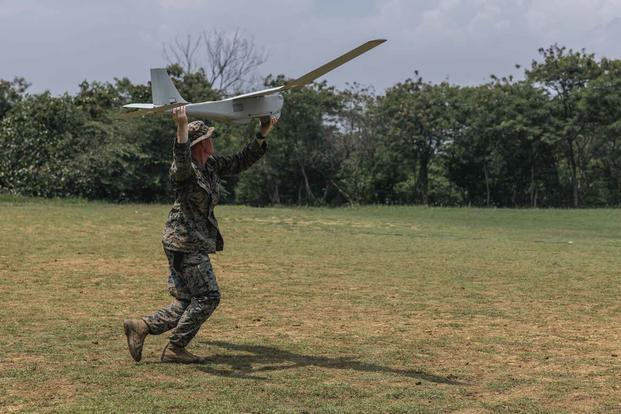Some Marine units rotating to the Pacific to bolster security in the region against Chinese influence do not have organic counter-drone capabilities and must rely on partnered forces to combat the unmanned aircraft, commanders for the units said Friday.
Commanders with Marine Rotational Forces South East Asia and Darwin, two rotational forces that train with U.S. allies in the Indo-Pacific to deter China through partnerships, told reporters they did not experience any drone threats during recent rotations. However, they said unmanned aircraft present a "wicked problem" that they do not have assets to combat on their own.
Drone use has surged in conflicts around the world as the technology has become cheap and widely dispersed, a massive shift from post-9/11 wars in which the U.S. used Predators and Global Hawks to dominate the skies. Now, drones are proliferating on battlefields such as Ukraine, Gaza and the Red Sea and in Iraq and Syria, where U.S. troops now face regular attacks.
Read Next: Guard Drug Task Force Member Arrested, Accused of Leaking Info to Drug Dealer
The Marine Corps said that its requirement for capabilities to defend against drones isn't new, and the service is working to get necessary gear "into the hands of Marines faster" with "urgently-fielded capabilities," Ashley Calingo, a spokesperson for Marine Corps Systems Command, said Monday.
Unmanned aircraft systems are "a wicked problem that everyone's working hard to come to grips with," Col. Brendan Sullivan, the commanding officer of Marine Rotational Force-Darwin, or MRF-D, told reporters Friday. "That's a huge focus of effort within the First Marine Division and a specific emphasis going for the division commander."
Sullivan said that, while MRF-D was in the Northern Territory of Australia, as well as in Indonesia and the Philippines, it did not have any contact with "unknown UAS" but noted that his unit did not have its own means to destroy drones. UAS stands for unmanned aircraft system.
"We're constantly working to achieve better signature management that allows us not only to reduce exposure to UAS, but all manner of overhead collect," he said.
Overhead collect refers to drones' ability to -- while sometimes undetected -- collect information on targets. In recent years, Chinese drone activity in and around the South China Sea has caused alarm for countries such as Taiwan. Last year, while the MRF-D was training with Australia, Japan and the Philippines, China flew a UAS off of Taiwan's east coast, USNI reported.
Col. Thomas Siverts, the commanding officer of the newly formed Marine Rotational Force-South East Asia, or MRF-SEA, also said that his unit did not experience any "exposure to any “outside UAS" during its rotations to the Pacific last year but conceded his unit also does not have capabilities "to counter UAS at this time, but we are certainly working on it."
He added that partner forces such as the Philippines and Indonesia have "robust" counter-drone programs.
The Marine Corps has previously emphasized the importance of counter-UAS operations in its Force Design 2030 concept, a plan to modernize the service within the next decade. In its updated concept published last year, the Marine Corps recognized international conflicts that have seen a proliferation of drone warfare in the last decade.
"Congress similarly recognized the trends emerging from the conflict in Ukraine, which provide evidence to support our close-combat lethality initiatives, focus on counter-UAS, and air and missile defense, and investments in precision fires to support distributed operations and maneuver," according to the Marine Corps design plan.
Programs that the Marine Corps is "actively pursuing" include the Marine Air Defense Integrated System, or MADIS, which is meant to protect critical assets from UAS, according to Calingo.
The other is the L-MADIS, a more mobile version of the system that gives Marine Expeditionary Units the ability to transport anti-drone capabilities via tilt and rotary wing aircraft.
In 2022, the Marine Corps highlighted its efforts to bring counter-UAS to the force in order to protect installations and infrastructure.
"The Marine Corps, and DoD in general, required the capability to defend against [small UAS] years ago," Don Kelley, who was program manager for ground-based air defense at the Marine Corps' PEO Land Systems, said in a press release at the time. "The threat of UAS is only proliferating every day. The bottom line is, we need to provide this capability to our Marines as rapidly as possible."
Calingo, the spokesperson for Marine Corps Systems Command, said Installation Counter Unmanned Aircraft Systems, or I-CUAS, are expected to be fielded to Marines in fiscal 2024 and will "defend covered assets on Marine Corps installations in the continental U.S. and in U.S. territories."
MRF-D, the rotational force based in Darwin, includes roughly 2,500 Marines while MRF-SEA, which completed its second rotation to the Indo-Pacific last month, is composed of nearly 200 Marines and sailors.
MRF-SEA conducted operations in the Philippines, Malaysia and Indonesia to -- in part -- "deter malign influence and support strategic competition efforts that contribute to regional stability in the Indo-Pacific," according to the Marine Corps.
Related: US and Britain Say Their Navies Shot Down 15 Attack Drones over the Red Sea














